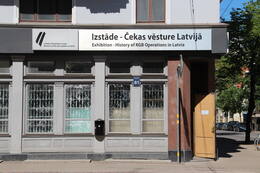Buvusio legiono leitenanto - čekų agento Arvīdo Gailīčio vaidmuo likviduojant Pēterio Čeverso grupuotę

Kapitonas Pēteris Čeversas ir dar septyni partizanai buvo sugauti 1950 metų lapkričio 1 dieną Engurės miško masyve, kur visai atsitiktinai netoliese buvo įsikūrusi netikra partizanų grupė, vadovaujama buvusio legiono leitenanto Arvīdo Gailīčio (agento-kovotojo slapyvardis „Grosbergs“). Jame buvo Latvijos TSR VDM operatyvininkai ir agentai-kovotojai, kurie apsimetė „miško broliais“.
Buvusio legiono leitenanto Arvīdo Gailīčio (agento-kovotojo slapyvardis „Grosbergs“) vadovaujama netikra partizanų grupė, kurioje buvo Latvijos TSR VDM operatyvininkai ir agentai-kovotojai, apsimetę „miško broliais“, klausydamiesi radijo išgirdo trukdžių švilpimą, kuris pasigirsta, kai miške ieškojo kito radijo, kas išėjo ir klausėsi radijo.
Prasidėjo abiejų grupių derybos dėl galimo bendradarbiavimo, nes Čeversas pasitikėjo legiono kovos bendražygiu Gailītiu, kurį asmeniškai pažinojo. 1-2, 1950 11 15 Lapkričio 15 d., per bendrą valgį Sulų girioje prie Plienciemo, septyni nacionaliniai partizanai – P. Čevers, J. Gura, A. Lauks, Ziedonis Als, Valdis Dzelzgalvis, A. Dundurs ir Ārends Lapiņš – buvo apnuodyti ir sumaišyti su operatyviniu specialiuoju agentu – be sąmonės esančiu alkoholiu.
Keturi miško broliai, tarp jų ir Čeveras, 1951 m. liepos 24 d. buvo nuteisti didžiausia bausme – sušaudymu, o kiti – ilgus metus kalėti Gulago lageriuose. Tik keli iš jų vėliau grįžo į tėvynę.
Šios tautinės partizanų grupės likvidavimą ypač tragišku daro tai, kad čekistai leitenantą A. Lauką privertė tapti išdaviku, kuris per Vasario 3-iosios mūšį psichologiškai palūžo, kai bandė nusišauti, tačiau vėliau buvo užverbuotas ir sovietų saugumo institucijoms teikė informaciją, dėl ko buvo suimti ar sunaikinti kiti vis dar laisvėje buvę Čeverio grupės nariai. 1952 m. kovo 31 d. paskutinis suimtas ir vėliau įvykdytas mirties bausmė buvo Artūrs Kalniņš ("Artūrs"), kuris persirengė moteriškais drabužiais ir slėpėsi pas savo merginą. Be to, jo buvimo vietą iš pavydo čekistams atskleidė buvusi Kalninio mergina.
Jei bendras Cheevero tautinių partizanų grupės narių skaičius siekė 20 žmonių, tai jų rėmėjų buvo beveik tris kartus daugiau – tai buvo mažiausiai 53 asmenys ir jų šeimos nariai.
Vandzenės partizanai ir jų rėmėjai. Blumų šeimos tragedija ir „Valdų“ namų paslaptis / Straipsnis (lsm.lv)
Uldis Neiburgs (dr. Hist., Latvijos universiteto Latvijos istorijos instituto mokslo darbuotojas)
Arvidas Gailitis (timenote.info) https://timenote.info/lv/Arvids-Gailitis
Zigmaras Turčinskis – Latvijos universiteto Latvijos istorijos instituto mokslo darbuotojas.
Susijusi laiko juosta
Susijusios temos
Susijusios vietos
Petro Čeverso nacionalinių partizanų bunkeris
Petro Čevero nacionalinių partizanų bunkeris yra Laucienės savivaldybėje, apie 4 km nuo Talsų–Upesgryvos kelio. Į jį veda medžio drožlėmis grįstas takas. Atnaujintas 31 kvadratinio metro ploto bunkeris pastatytas iš betoninio karkaso, apdailintas pusrąsčiais, kad būtų sukurtas autentiškas vaizdas.
Kapitono Čeverio grupė bunkerį miške netoli Vangzenės baigė statyti 1949 m. spalio pabaigoje. Buvo planuojama išgyventi 1949–1950 m. žiemą. 1950 m. vasario 3 d. vietos miškininkas išdavė partizanus, ir bunkerį užpuolė daugiau nei 300 kareivių Čekos dalinys. Tuo metu bunkeryje buvo 19 žmonių – 17 vyrų ir dvi moterys. Šioje nelygioje kovoje žuvo šeši partizanai, tačiau kitiems pavyko pralaužti dvi Čekos apgulties grandines, kovojant. Žiemos pabaigoje partizanai su savo rėmėjais slėpėsi aplinkiniuose namuose, tačiau pavasarį grupė vėl susivienijo, kol 1950 m. lapkritį buvo užimtas ir sunaikintas. Po Čekos kariuomenės puolimo bunkeris buvo susprogdintas, ir prieš jį atstatant liko tik vandens pripildyta duobė.
Paroda KGB pastate „KGB operacijų Latvijoje istorija“
Buvęs SSRS Valstybės saugumo komiteto (paprastai vadinamas Čeka) pastatas atviras lankytojams. Čia čekistai kalindavo, tardydavo ir žudydavo Latvijos piliečius, kuriuos okupacinis režimas laikė priešininkais. Taip pat eksponuojama Latvijos okupacijos muziejaus ekspozicija apie Čekos veiklą Latvijoje. Siūlomos ekskursijos po kalėjimo kameras, koridorius, rūsį ir kiemą. Namas pastatytas 1911 m. ir yra vienas gražiausių pastatų Rygoje. Liaudyje vadinamas „Kampiniu namu“, jis buvo baisiausias sovietinio okupacinio režimo simbolis Latvijoje ir vienas iš SSRS valdžios ramsčių. Čeka iš Kampinio namo veikė okupacijos metu nuo 1940 iki 1941 m., o vėliau nuo 1945 iki 1991 m. Dešimtys tūkstančių latvių nukentėjo nuo tiesioginio politinio persekiojimo. Kova su sovietų valdžios priešais tęsėsi ir po Antrojo pasaulinio karo. Čekos požiūris į savo veiklą šiek tiek pasikeitė po Stalino mirties. Fizinį kankinimą pakeitė psichologinis teroras. Dauguma Čekos agentų buvo latviai (52 %). Antra pagal dydį grupė buvo rusai – 23,7 %. 60,3 % agentų nebuvo Komunistų partijos nariai. 26,9 % agentų turėjo aukštąjį išsilavinimą. Sistema buvo sukurta taip, kad įtrauktų vietos gyventojus ir taip turėtų didesnę kontrolę visuomenėje. Personalo dokumentai ir tarnybos įrašai yra Rusijoje. Ši medžiaga nebuvo prieinama Latvijos valdžios institucijoms ir tyrėjams.









